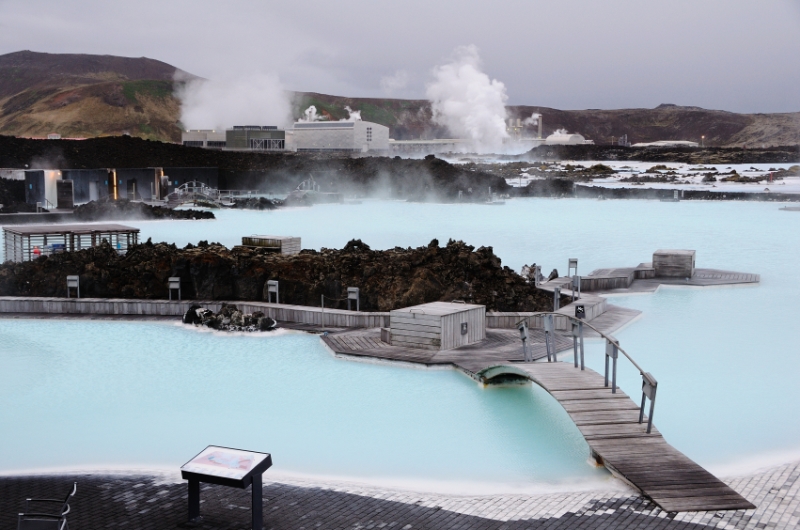Geothermal energy
Geothermal energy refers to heat energy stored in the ground, where "Geo" means 'from the Earth' and "thermal" means 'heat'.
A natural example of geothermal energy are geysers. Geysers use heat from deep underground to heat water, as the water is heated steam forms, pressure builds up and the geyser erupts. Geothermal energy was first harnessed by humans using geysers to provide hot bathing water.
 The naturally heated rich mineral waters of the Blue lagoon in Ireland. Source: iStock.
The naturally heated rich mineral waters of the Blue lagoon in Ireland. Source: iStock.
Today geothermal energy is becoming a more and more popular method of heating homes in Ireland. It is a renewable resource and so is a sustainable way to provide heating and hot water to homes. Compared to the burning of fossil fuels geothermal energy has huge environmental benefits.
There are two main sources of heat for the Earth, the hot core of the planet and heat from the sun. Depending on the depth, this energy can be split into two categories, shallow and deep geothermal.
Shallow
The Earth's surface acts like a huge solar collector, as the sun radiates energy the Earth absorbs this energy and stores it below it's surface. The use of geothermal energy in the home harnesses this heat energy stored by the Earth. Ireland is particularly well suited to harnessing this energy as soil and groundwater temperatures remain almost constant throughout the year.
To harness this energy for use in the home, ground source heat pumps are used. These ground source heat pumps are usually made up of 3 components, the collector/ loop absorbs the heat from the ground, the heat pump converts this heat energy from the ground into useable energy in your home and the distribution system maintains the temperature in your home by heating or cooling as required.

The step by step diagram above shows how the geothermal energy is used; pipes are laid out and buried in the garden, the system pumps a liquid through the pipes to absorb the heat and brings it back indoors.
Inside the pump acts as a "heat exchanger" taking the heat from the liquid and using it to heat the air inside the home with the help of radiators or underfloor heating.
A geothermal system can also be used to cool your house during the summer. By working in reverse it absorbs the heat from the air inside the house and transfers it back into the earth.
If your home is well insulated this is a very energy-efficient method of heating. Almost none of the energy used is wasted. This helps keep heating bills very low during the winter and also has huge environmental benefits.
Deep geothermal
The centre of the earth has a temperature of approximately 4,2000C. This heat is produced mainly from the decay of radioactive isotopes in the ground which give off heat as they break down. By the time this heat reaches the Earth's surface it is at too low a temperature for it to be used in the home. This type of deep geothermal energy is only useful when it reaches the surface through faults in the Earth's crust, this is common in volcanic areas, or by drilling deep into the surface to access it.
In volcanic areas such as Iceland geothermal energy provides almost all of their home heating requirements.
Deep geothermal energy can also be used to produce electricity, this is considered a clean method of producing electricity as no fuels are burned therefore no harmful pollutants are released. Geothermal power plants dig wells deep into the Earth to reach geothermal reservoirs which are usually found along plate boundaries. There are a couple of different ways of using geothermal energy to make electricity.
Hydrothermal, this is the most common type of geothermal energy used to produce electricity. Here steam and hot water from the reservoirs are used. Steam is pumped up the well and is used to drive a huge turbine, this turbine spins a magnet which generates electricity.